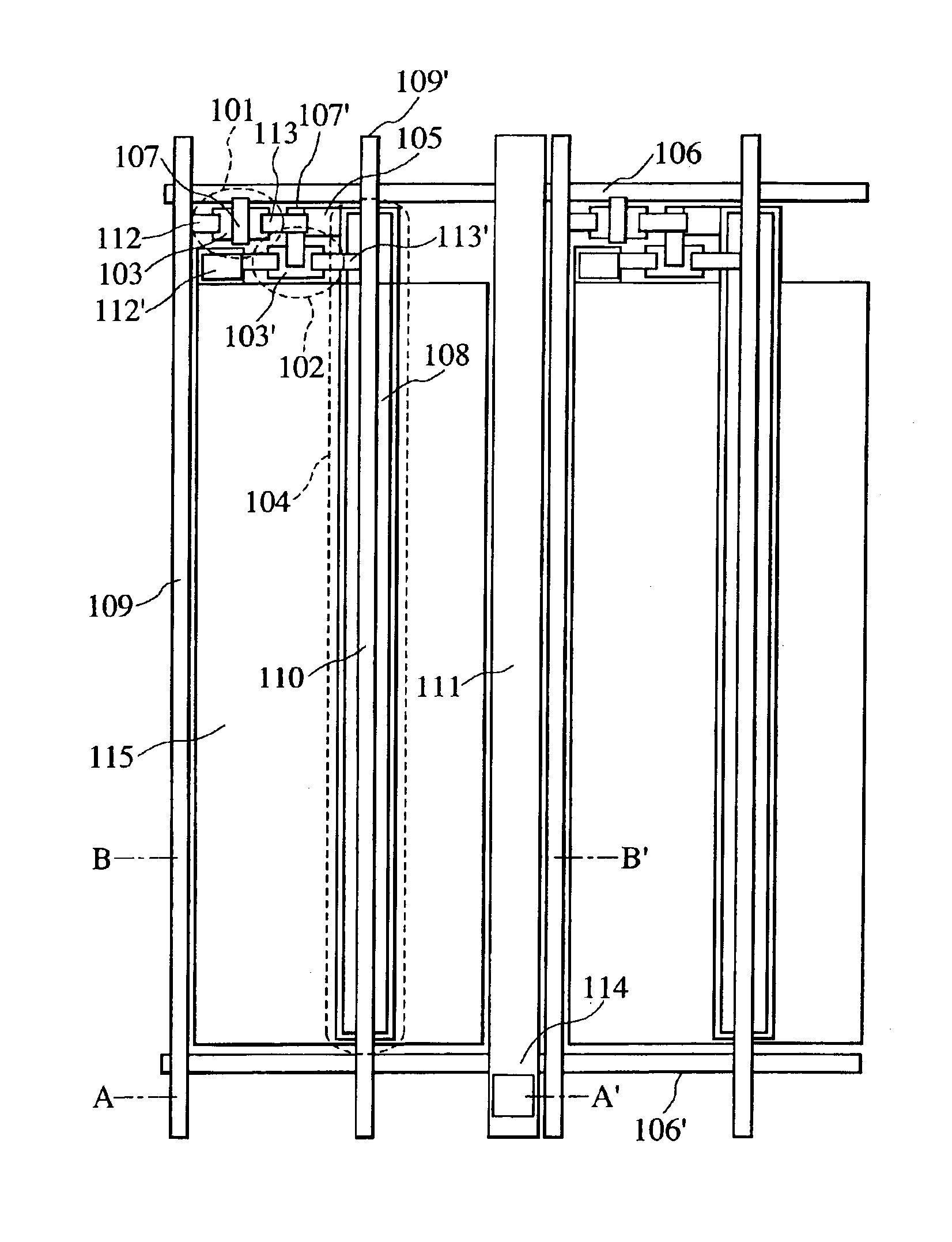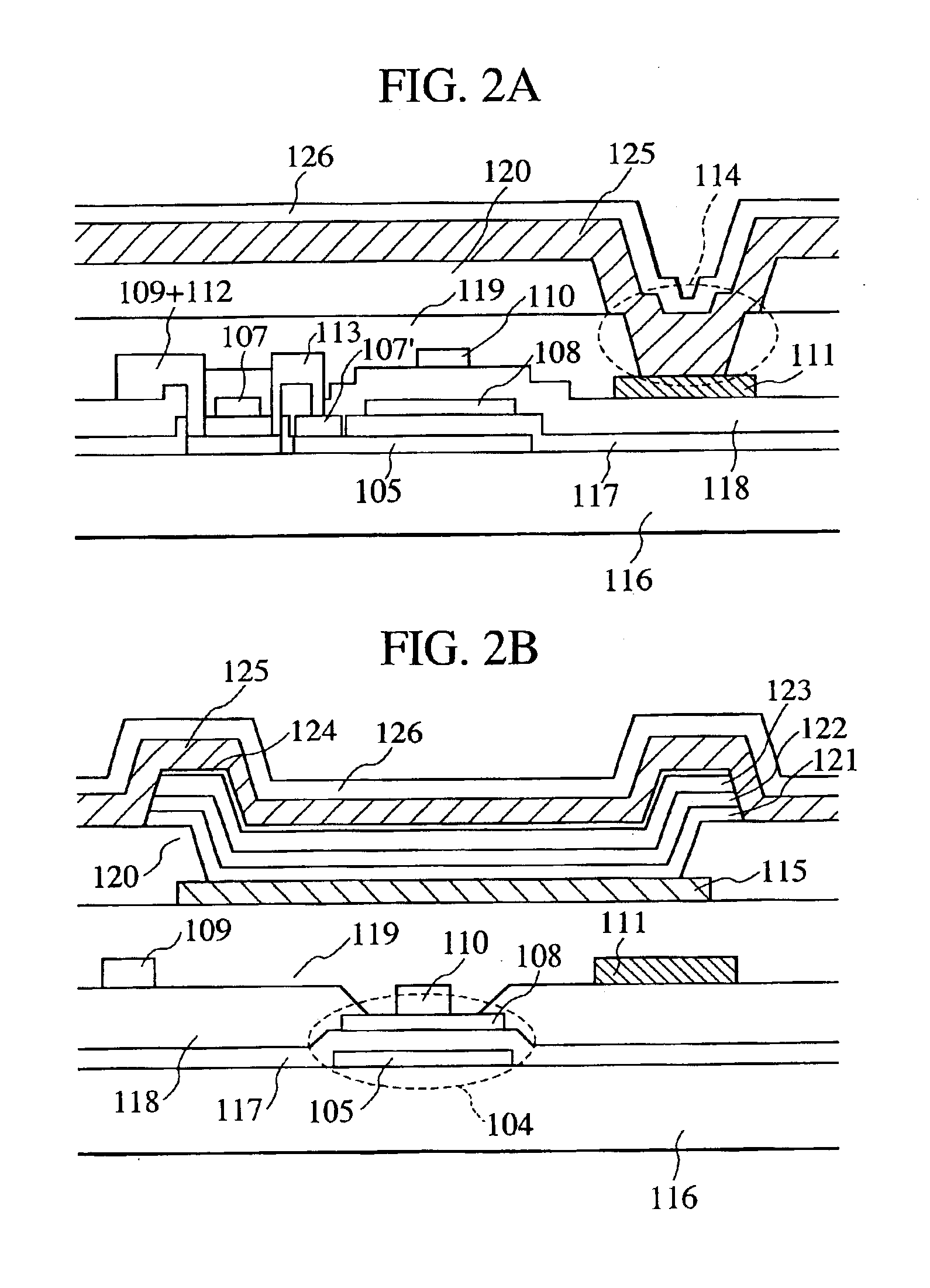Organic light-emitting display device
a display device and organic technology, applied in the direction of luminescnet screens, discharge tubes, identification means, etc., can solve the problems of low-speed response characteristics, narrow visibility angle, shortening the life of organic light-emitting devices, and generating variations in brightness in display devices, etc., to achieve the effect of reducing the resistance of wiring connected to an electrod
- Summary
- Abstract
- Description
- Claims
- Application Information
AI Technical Summary
Benefits of technology
Problems solved by technology
Method used
Image
Examples
embodiment 1
[Embodiment 1]
An organic light-emitting display system according to a first embodiment of the present invention will be described below with reference to the drawings. FIG. 1 is a plan view of a pixel in the organic light-emitting display device; FIG. 2A is a sectional view taken along line A-A′ of FIG. 1; and FIG. 2B is a sectional view taken along line B-B′ of FIG. 1. In FIGS. 1, 2A and 2B, a plurality of scanning lines 106, 106′ are disposed at a predetermined interval on a glass substrate 116, and signal lines 109, 109′, 109″ for transmitting picture data and the like are disposed at a predetermined interval in a direction orthogonal to each of the scanning lines. That is, the scanning lines and the signal lines are arranged in a grid form, and the region surrounded by a pair of the scanning lines and a pair of the signal lines constitutes a display region for one pixel. On the glass substrate 116, a plurality of first current supply lines 110 connected to a plus terminal of a p...
embodiment 2
[Embodiment 2]
A full color organic light-emitting display device according to a second embodiment of the present invention will be described with reference to FIGS. 4 and 5. This display device comprises a second current supply line and a feeding point at a lower portion of a green emission pixel region, and it has a high efficiency and a long life. FIG. 4 is a plan view of a pixel of an organic light-emitting display device according to this embodiment, and FIG. 5 is a sectional view taken along line A-A′ of the pixel region shown in FIG. 4.
The present embodiment has a structure in which, to display a color picture, a plurality of pixels serving as minimum units of the color picture are provided; green, red and blue organic light-emitting devices are provided as sub-pixels constituting each pixel; and a second electrode 125 of the organic light-emitting device of each pixel is connected to a second current supply line 111 in the display region of the green organic light-emitting de...
embodiment 3
[Embodiment 3]
A full-color organic light-emitting display device according to a third embodiment of the present invention will be described with reference to FIGS. 6 and 7. This display device, which comprises a second current supply line and a feeding point at a lower portion of a green light emission pixel region, is so constructed as to take out light from the back side of a substrate, and has a high efficiency and a long life. FIG. 6 is a plan view of a pixel of the organic light-emitting display device in this embodiment, and FIG. 7 is a sectional view taken along line A-A′ of FIG. 6.
In this embodiment, a sealing substrate 309 for the purpose of preventing water, oxygen and the like gases in the atmosphere from penetrating into a second electrode 125, an organic layer under the second electrode, or the interface between the second electrode and the organic layer is provided on the upper side of the second electrode 125, the other constitutions being substantially the same as in...
PUM
 Login to View More
Login to View More Abstract
Description
Claims
Application Information
 Login to View More
Login to View More - R&D
- Intellectual Property
- Life Sciences
- Materials
- Tech Scout
- Unparalleled Data Quality
- Higher Quality Content
- 60% Fewer Hallucinations
Browse by: Latest US Patents, China's latest patents, Technical Efficacy Thesaurus, Application Domain, Technology Topic, Popular Technical Reports.
© 2025 PatSnap. All rights reserved.Legal|Privacy policy|Modern Slavery Act Transparency Statement|Sitemap|About US| Contact US: help@patsnap.com



